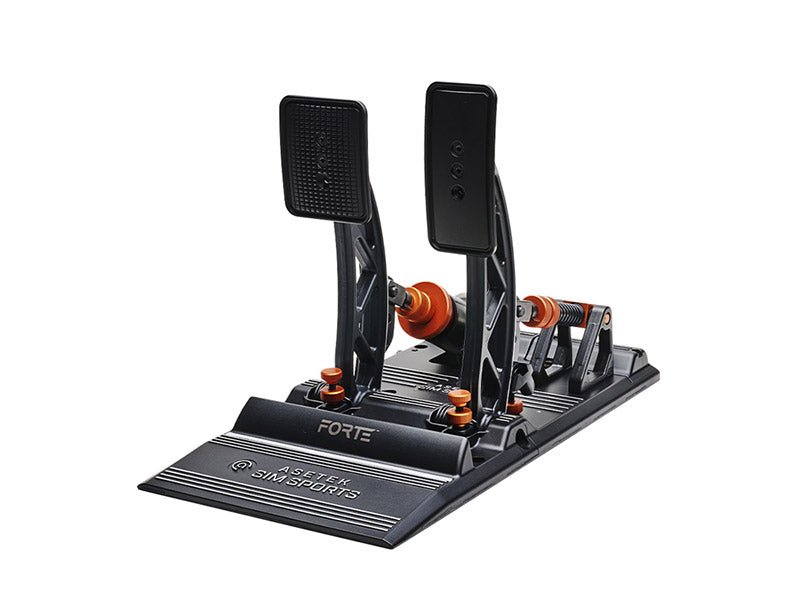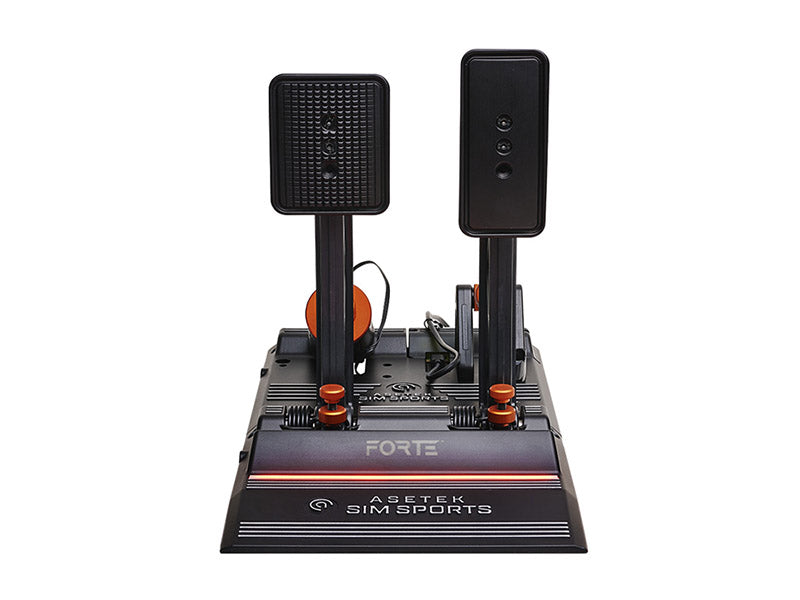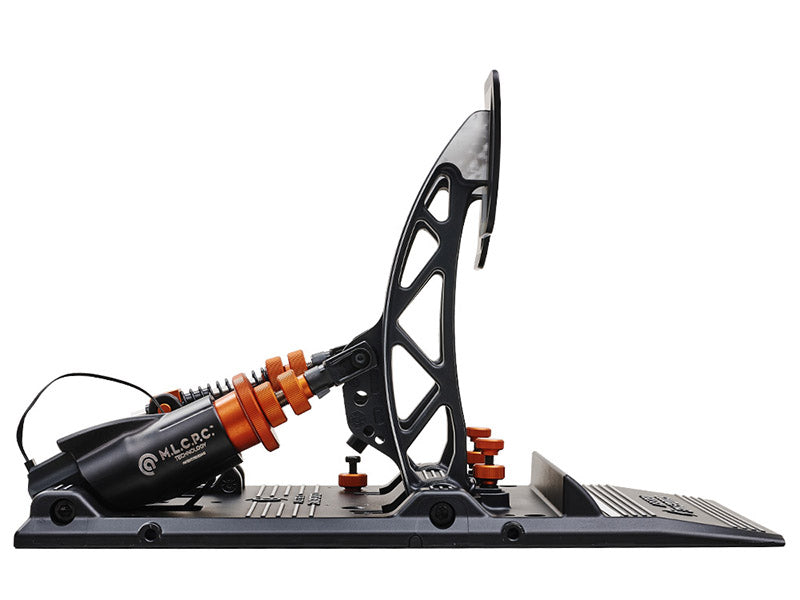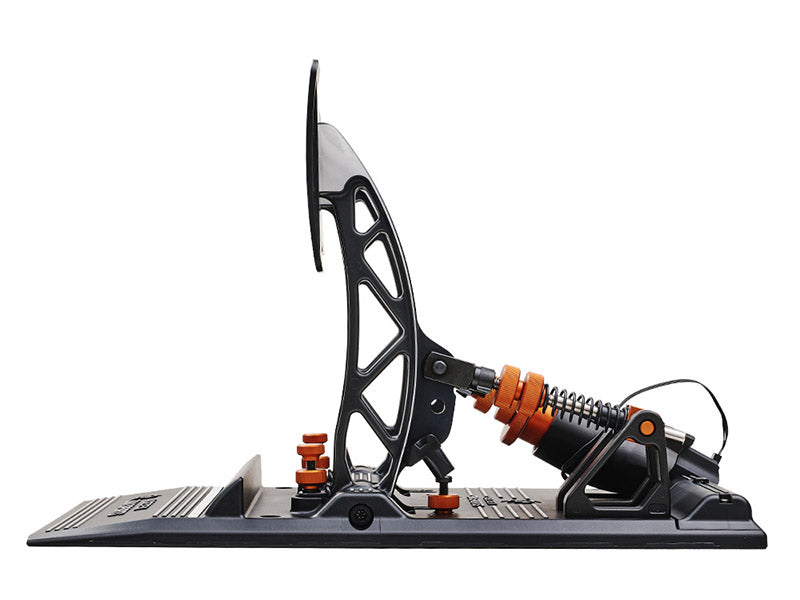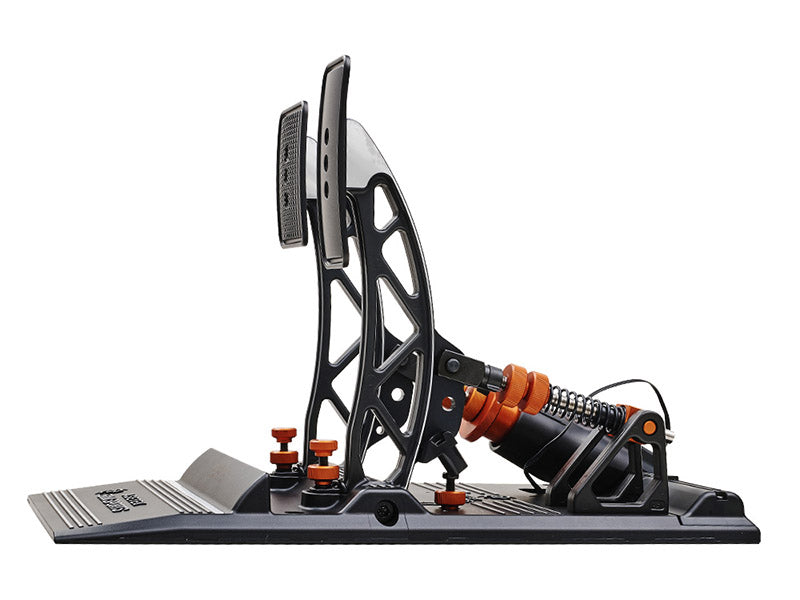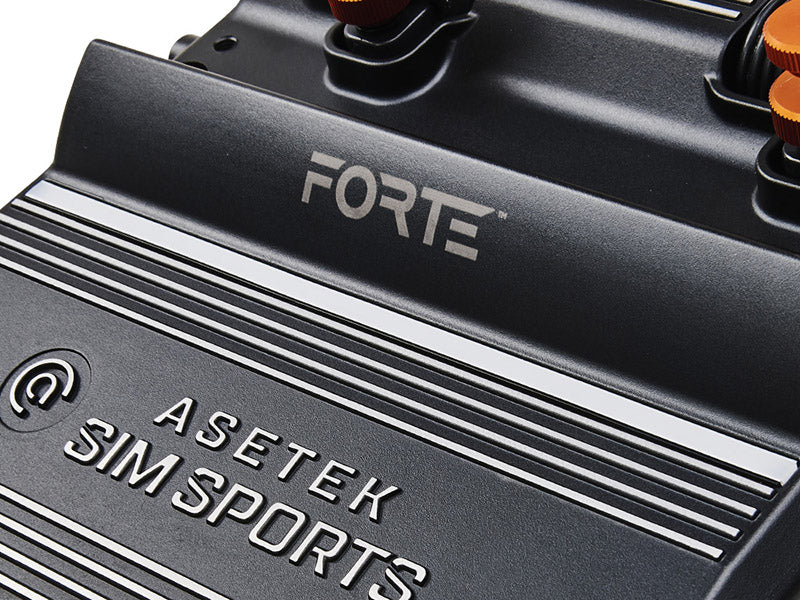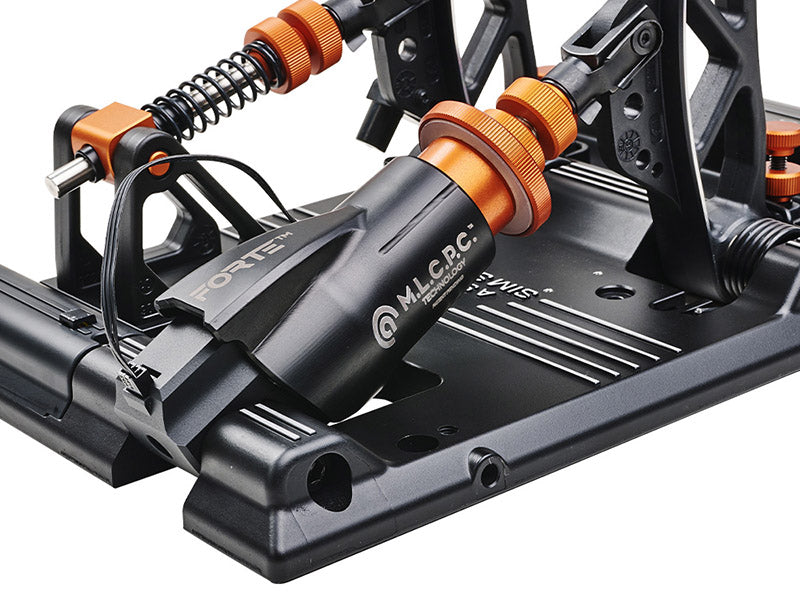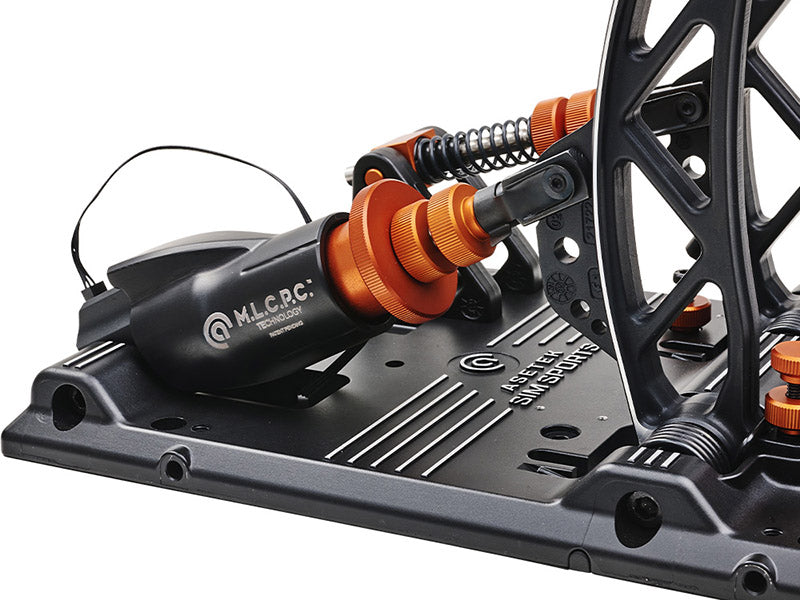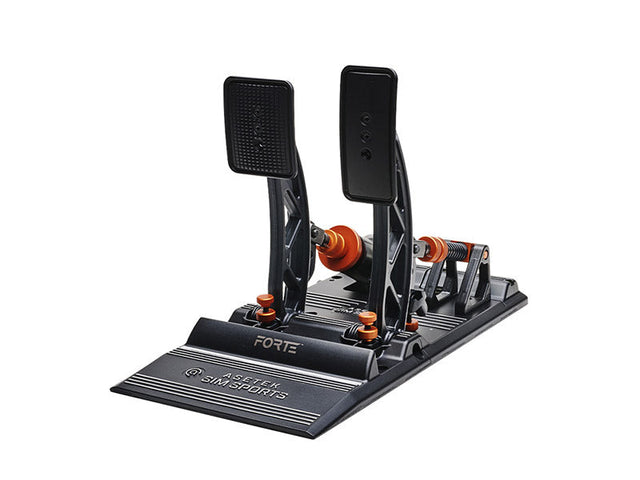Asetek SimSports Forte Sim Racing Pedals Brake and Throttle
Asetek SimSports Forte Sim Racing Pedals Brake and Throttle is backordered and will ship as soon as it is back in stock.
Couldn't load pickup availability
Parcel Insurance
Parcel Insurance
Parcels are insured for loss and damage up to the value as stated by the courier.
Returning an item
Returning an item
If you are not completely satisfied with your purchase, please contact our customer service team at sales@simdemon.com or call 0121 285 9591.
Our returns policy is available here.

Forte SIM Racing Pedals Brake and Throttle
Immerse yourself with the real-life racing inspired Forte Sim Racing Pedals.
By utilizing a M.L.C.P.C (Mechanical Load Cell Powered Cylinder) System, these sim racing pedals pave the way for authentic racing by simulating the sensation of a real race car without going full hydraulic.
The Forte Sim Racing Pedals have been thoroughly tested by both racers and sim enthusiasts, and with that feedback in mind, the pedals are engineered and designed to replicate the real deal and give you that competitive edge.
Inspired By Real-Life Racing
The design of the Forte Pedals is crafted with user experience in mind, featuring color-coded adjustable elements for a quick start and ensuring intuitive and mostly tool-less usage.
The sim racing pedals are highly adjustable, allowing you to channel your inner racer and easily customize the travel and hardness settings to your exact preferences.
Furthermore, while the Forte Pedals are not hydraulic, they still offer the hydraulic sensation of a fully depressed brake pedal because of the M.L.C.P.C. System. This allows you to pressure modulate and trail brake – thanks to the 2-stage system inspired by the Invicta Pedals.
The Benefits of a Hard Brake Pedal
Having a hard brake pedal will allow your muscle memory to be trained to perfection. Muscle memory is the subconscious telling your muscles just the right amount of pressure, leaving your conscious mind to take care of more important things at that moment – like watching traffic or hitting apex.
Your muscle memory system is not wired to remember a position. Try to lift your hand with your eyes closed and reach the same spot within 0,5 mm 10 times in a row, and you will get the point. On the flip side, your muscle memory can memorize a pressure extremely accurately, meaning going around a track, your muscle memory can make you brake the same way again and again. This cannot be achieved with a soft pedal – especially when trail braking.
Brake Later Get Faster
Furthermore, a hard brake pedal will allow you to brake later. Imagine having a brake pedal with 50 mm (common for many sim racers) of travel versus a brake pedal with almost zero travel.
You are going 300 km/h down a straight. With the long travel brake, it will physically take you perhaps 1/10 of a second more to reach full braking power. On the stiff brake pedal, you will reach maximum braking power instantly.
If you have three hard braking zones on a track, you will gain 3/10 of a second each lap by using a hard brake with minimal travel.
THE M.L.C.P.C.™ SYSTEM
Most mechanical sim racing pedals on the market have an ‘unlimited’ travel, essentially determined by how hard you squeeze the elastomer. Often, the elastomer is overworked (compressed beyond its design), resulting in a spongy and inconsistent brake feel, eventually leading to the elastomer breaking due to being overworked and out of specification.
But, most importantly, with the longer brake pedal travel, you have to brake earlier to build up full brake pressure and lose out on important milliseconds every lap.
To avoid that, the functionality of the M.L.C.P.C System is based on two stages – the soft stage and the hard stage – just like in a real race car and the Invicta Pedals.
01. THE SOFT STAGE
Real race car:
When you apply pressure on the pedal, it will move 10-20 mm (measured on the pedal plate), while you build up pressure, while the caliper pistons are traveling to and pushing the brake pads against the brake disc, and to compensate for the small amount of play in all the mechanical parts on the pedal system that is required for them not to seize up.
The M.L.C.P.C System:
In our pursuit of creating the most authentic race car feel, we've incorporated a mechanical stop in the M.L.C.P.C. System. That means you can adjust the hardness of the soft stage by changing elastomers, but the travel will be limited to 15-25 mm on the pedal plate (around 12 mm piston travel in the M.L.C.P.C cylinder).
02. THE HARD STAGE
Real race car:
When hydraulic pressure is built up, the brake pads are squeezing the discs hard and all mechanical play is compensated. In this stage, your foot is basically pressing against a wall, because now your muscles are pressing directly against the hydraulic forces (the brake fluid). Since the fluid cannot be compressed, you will feel the pedal is hard.
When a racecar driver complains about a “long” or a “soft” pedal, it is typically because there is air in the system, and since air CAN be compressed, the pedal will feel soft and long. The mechanics then bleed the brakes for air, meaning there is only fluid left in the system, and the pedal is once again hard after passing the “soft stage”.
The M.L.C.P.C. System:
To simulate the ‘hard stage’ where it feels like pressing against a concrete wall, we have implemented a rubber damper, which will simulate the fully engaged brake caliper but still enable the load cell sensor to measure additional pedal pressure, which makes perfect trail braking possible. This is the same feeling you get in a real race car.
PC
Console support planned in the future
Platforms
- Windows 10
- Windows 11
Products
- Invicta™ Clutch System
- La Prima™ Clutch System
- Invicta Pedal Face Plates
- Elastomer Kit
- Universal Footrest
Games
- Assetto Corsa
- Assetto Corsa Competizione
- DiRT Rally
- DiRT Rally 2.0
- F1 Series
- iRacing
- Project Cars 2
- rFactor 2
- And many more (all games that accept direct input devices)
Box Contents
- Forte® Throttle
- Forte® M.L.C.P.C. Brake
- USB Type-A to USB Type-C cable 1.5m
- USB Type-C to USB Type-C cable 1.5m
- M6x5 Set screw (x2)
- M6x20 bolt (x8)
- M6 Slot nut (x8)
- Washer (x8)
- M6 Hex nut (x8)
- Allen key, 3mm
- Allen key, 5mm
- Elastomer, Soft
- Elastomer, Hard (pre-installed)
- Throttle Spring, Medium (pre-installed)
- Throttle Spring, Soft
Tech Specs
- Exquisite, radical, and minimalistic industrial Danish design (Registered Community Design No. 009148265-0001/0002/0003)
- Adjustable pedal stops
- Adjustable travel settings
- All-black anodized aluminum pedal base and pedal arms with CNC machined contrast cut
- All-black anodized aluminum smooth and sock-friendly pedal plates, adjustable vertically for comfort
- Pedal base with integrated heel rest and RGB LED adjustable via RaceHub software
- Calibrations made in RaceHub saved in EPROM, ensuring settings persist across simulators/games
- Single USB connection to the PC for pedal base regardless of 2 or 3 pedal use
- All adjustable mechanical features are colored orange by default
- In-house developed electronics with 16-bit resolution
- Easy to add clutch pedal to the Forte Throttle & Brake combo
- Designed and tested to exceed +1,000,000 activations
Dimensions
- Depth, width, and height: 457 mm x 212 mm x 256 mm
- Weight: 3 kg
Brake System
- M.L.C.P.C. (Mechanical Load Cell Powered Cylinder) patent-pending brake cylinder for real race car experience
- Die-cast aluminum zero play pedal arm with integrated long durability ball bearings and bronze bushing
- Load cell senses up to 180 kg of force with hardest elastomer (4000N deflected 12mm)
- Geared ratio for constant resolution independent of elastomer hardness; 4000 points within 12mm range
- Two-stage system mimics soft and hard stages of a real race car brake
- Two interchangeable elastomers for hardness adjustment with integrated stop and expansion chamber
- Manually adjustable initial touch hardness for brake pad to brake disc simulation
- Pedal arm designed to handle up to 200 kg of force with burst pressure up to 700 kg
Throttle System
- Die-cast aluminum zero play pedal arm with integrated long durability ball bearings and bronze bushing
- 16-bit magnetic wireless hall TPS (Throttle Position Sensor) for maintenance-free, precise throttle control
- Customizable throttle curves via RaceHub software to simulate race car butterfly opening
- Adjustable pedal hardness, travel, and stop
- Interchangeable spring for greater adjustment in pedal hardness
- Pedal arm designed for 200 kg of force with burst pressure up to 700 kg
In the event that your ASETEK Product develops a fault, ASETEK's support team will be able to help. Click Here For Asetek Support.
When contacting support make sure to provide them with as much detail as possible to achieve a quick resolution to your issue.
- Your Original Invoice From Us
- Serial Number of your product
- Pictures and Videos of the issue
- The Log File From ASETEK Race Hub
All Asetek Products Have a 24 Month Warranty.
Safe & Secure
Your payment information is processed securely. We do not store credit card details nor have access to your credit card information.


